

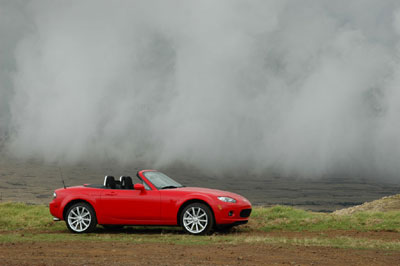 The
design of the all new 3rd generation MX-5/Miata can best be described by the
Japanese expression Jinba Ittai, which literally translates to "horse
and rider as one." The "Kansei Engineering" philosophy
- that each individual component contributes to the goodness as a whole, blah
blah blah, …
The
design of the all new 3rd generation MX-5/Miata can best be described by the
Japanese expression Jinba Ittai, which literally translates to "horse
and rider as one." The "Kansei Engineering" philosophy
- that each individual component contributes to the goodness as a whole, blah
blah blah, …
Kansei, shman-sei - where are the keys? Lets see what this baby's all about!
Roadster Madness
Sixteen years ago, the Mazda MX-5 Miata was born, single-handedly resurrecting the popularity of the small, lightweight, open-top roadster. Almost declared dead due to strict US safety standards, there was no public clamoring for a new roadster. Enter a group of "car guys" over at Mazda who really wanted to build a low cost sports car - just for themselves. They did it. They did it well. And the aficionados came. Lots of 'em.
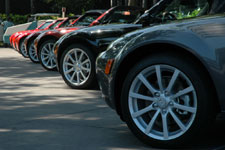 Three
quarters of a million MX-5 Roadsters later (a Guinness world record), Mazda
unleashed the newest incarnation of the breed. The completely new, ground up
redesign of the Miata shares only one component of the earlier cars: the European
model side indicators. The US model reuses nothing! (Though we suspect the valve
stems are probably the same, too.) The emphasis on weight reduction, increased
rigidity, and higher performance while maintaining the goal of keeping the Miata
affordable, takes the Zoom-Zoom concept to the next level.
Three
quarters of a million MX-5 Roadsters later (a Guinness world record), Mazda
unleashed the newest incarnation of the breed. The completely new, ground up
redesign of the Miata shares only one component of the earlier cars: the European
model side indicators. The US model reuses nothing! (Though we suspect the valve
stems are probably the same, too.) The emphasis on weight reduction, increased
rigidity, and higher performance while maintaining the goal of keeping the Miata
affordable, takes the Zoom-Zoom concept to the next level.
But enough of this PR talk - I'll get back to that later. The bottom line:
It rocks!
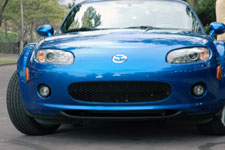 Truth
be told, I was prepared for disappointment. Lurking in the back of my mind was
the demise of the RX-7. Mazda designed a great car for the third generation
7, but managed to price it so high, it completely alienated the original buyers.
With the trend toward adding more and more "creature comforts", on
top of mandated federal standards, while still trying to keep the stockholders
happy by reducing cost - a ground-up redesign had all the makings of a disaster.
Truth
be told, I was prepared for disappointment. Lurking in the back of my mind was
the demise of the RX-7. Mazda designed a great car for the third generation
7, but managed to price it so high, it completely alienated the original buyers.
With the trend toward adding more and more "creature comforts", on
top of mandated federal standards, while still trying to keep the stockholders
happy by reducing cost - a ground-up redesign had all the makings of a disaster.
Thank goodness I was wrong! Or perhaps more appropriately, thank Takao Kijima - the MX-5 Program Manager. Having been responsible for development of the suspension on the first generation Miata, Kijima-san has over 19 years of experience with the MX-5 Miata. It should not come as a surprise that this car's handling is splendid! Working with design chief Yasushi Nakamuta and powertrain development lead Tetsuo Fujitomi, the design teams put together a truly great sports car, and did so at a price point that should keep enthusiasts coming for years!
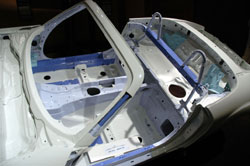 Driving
the new Miata is really something. The handling characteristics are most definitely
superior to the first and second generation Miatas. Starting out on straight,
easy, low speed roads, the sport suspension was so soft and comfortable that
I was expecting it to be sluggish in the turns. But hitting the twisties revealed
the true character of the '5 - tight and stiff with very little body roll, coupled
with an incredibly quick, precise and crisp steering response. With only 2.6
turns lock-to-lock (the 1990 was a whopping 3.3), it was like steering with
the eyes - look in a direction, and the car just goes there. And yet, it still
retains the predictability we've grown to expect in a stock Miata. Breaking
the rear loose is smooth and predictable, with recovery equally simple and natural.
Driving
the new Miata is really something. The handling characteristics are most definitely
superior to the first and second generation Miatas. Starting out on straight,
easy, low speed roads, the sport suspension was so soft and comfortable that
I was expecting it to be sluggish in the turns. But hitting the twisties revealed
the true character of the '5 - tight and stiff with very little body roll, coupled
with an incredibly quick, precise and crisp steering response. With only 2.6
turns lock-to-lock (the 1990 was a whopping 3.3), it was like steering with
the eyes - look in a direction, and the car just goes there. And yet, it still
retains the predictability we've grown to expect in a stock Miata. Breaking
the rear loose is smooth and predictable, with recovery equally simple and natural.
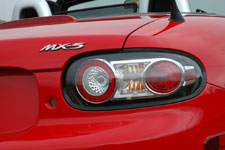 Power
delivery is also much smoother and more constant than the early cars. The torque
curve feels more linear. Recalling the first generation MX-5 Miata, the takeoff
torque was feeble, at best. The nonlinear acceleration of the past models gave
a sensation of being pulled back into the seat as the rev counter climbed through
4,000 rpm up to the redline. Generation 3 has more torque at the low end, followed
by a smooth, even delivery, still pulling up to the rev limiter. As a result,
it doesn't provide the same "sensation" of speed like its predecessors.
However I suspect it actually has more - it's just that the torque curve was
made more linear. I'm OK with that - I'd rather have more real power than perceived
power. And the power is real - the 170 ponies pulling only 2473 lbs. of aluminum
and steel yields a horsepower-to-weight ratio 25% higher than the original 1990
Miata!
Power
delivery is also much smoother and more constant than the early cars. The torque
curve feels more linear. Recalling the first generation MX-5 Miata, the takeoff
torque was feeble, at best. The nonlinear acceleration of the past models gave
a sensation of being pulled back into the seat as the rev counter climbed through
4,000 rpm up to the redline. Generation 3 has more torque at the low end, followed
by a smooth, even delivery, still pulling up to the rev limiter. As a result,
it doesn't provide the same "sensation" of speed like its predecessors.
However I suspect it actually has more - it's just that the torque curve was
made more linear. I'm OK with that - I'd rather have more real power than perceived
power. And the power is real - the 170 ponies pulling only 2473 lbs. of aluminum
and steel yields a horsepower-to-weight ratio 25% higher than the original 1990
Miata!
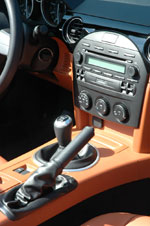 Despite
the increase, there will be some who still consider this an underpowered sports
car. But with a 2.0 liter four-banger as a starting point, the aftermarket should
have a good time finding ways to make everyone happy. Engine maintenance will
be a bit easier as well. The timing belt has been replaced with a no-maintenance
chain, and its higher strength permits the use of an interference design. A
single serpentine belt is used to keep all the bits running.
Despite
the increase, there will be some who still consider this an underpowered sports
car. But with a 2.0 liter four-banger as a starting point, the aftermarket should
have a good time finding ways to make everyone happy. Engine maintenance will
be a bit easier as well. The timing belt has been replaced with a no-maintenance
chain, and its higher strength permits the use of an interference design. A
single serpentine belt is used to keep all the bits running.
The shifter retains one of the favorite characteristics of Miata drivers - a quick, precise, short throw that makes driving a pleasure. The tight gearing of the 6-speed manual gearbox (5-speed in the Club Spec, MX-5, and Touring models) helps to keep the engine spinning at optimal speed when quickly running through the gears.
Dials and buttons and lights, no more!
The trend in the automotive industry toward making a big control panel with lots of buttons, switches, indicators, and other electronic bling has made most cockpits look like a 747. Mazda has taken a great step toward reversing that trend with a very simple design that is easy to navigate. The audio system has only 15 buttons and two dials, all laid out in a very logical, easy to use fashion. The no-nonsense design only takes a few minutes to figure out. Similarly, the climate controls are set up with a well thought out pod of three combination dials. The leftmost controls the air vents with a push function to turn the rear window defogger on and off. The middle dial tunes the heating/cooling level with the push function controlling the recirculation. The right side knob selects fan speed, with the button to enable the air conditioning. Easy stuff!
Those nasty creature comforts...
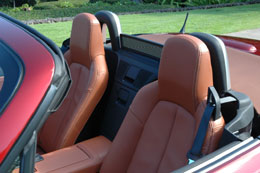 Cup
holders don't belong in sports cars. There, I said it. Furthering this folly,
it wasn't enough to have a cupholder on each door. Two more had to be added
to the console. Four, count 'em, cup holders in a two-seat sports car! A fine
impression we've given to the design team if they think that's really needed.
Though I suppose one saving grace is that holes have no weight. Maybe more
holders are needed to save weight. We can have holes in the dash to accommodate
a pair of Big Macs, two more holes to take a couple of jumbo fries, and of course
we'll need a condiments tray. But then, all the weight saved with all those
holes would be offset by a corresponding gain in occupant weight.
Cup
holders don't belong in sports cars. There, I said it. Furthering this folly,
it wasn't enough to have a cupholder on each door. Two more had to be added
to the console. Four, count 'em, cup holders in a two-seat sports car! A fine
impression we've given to the design team if they think that's really needed.
Though I suppose one saving grace is that holes have no weight. Maybe more
holders are needed to save weight. We can have holes in the dash to accommodate
a pair of Big Macs, two more holes to take a couple of jumbo fries, and of course
we'll need a condiments tray. But then, all the weight saved with all those
holes would be offset by a corresponding gain in occupant weight.
Four cup holders indeed.
But it does feel good
The cockpit of the MX-5 is designed for the driver. That's not to say that the passenger is ignored, however this is clearly a driver's car, and where tradeoffs were made, they favor the driver.
The third generation seats are the best yet. Big, beefy side bolstering keeps everyone where they're supposed to be. The seating level is a bit lower than in prior years - a more sports car like attitude. Good lumbar and thigh support makes the driver feel secure and comfortable.
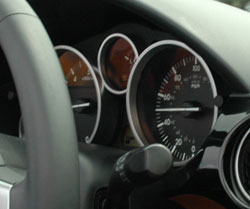 The
driver's footwell has been enlarged, primarily due to the exhaust manifold having
moved to the right-hand side of the new motor. The slightly cramped feel of
the second generation Miata has been rectified, as well as the tendency for
heat build up which often required air conditioning vents to be directed toward
the feet. That's the good news. The bad news is that the passenger's footwell
has shrunk, with the space being slightly right of center. This forces the passenger
to adopt a leg position that is slightly angled toward the right, with a corresponding
back position that gradually migrates to the left bolster. This may cause some
passenger fatigue in long trips. But hey - I said its a driver's car!
The
driver's footwell has been enlarged, primarily due to the exhaust manifold having
moved to the right-hand side of the new motor. The slightly cramped feel of
the second generation Miata has been rectified, as well as the tendency for
heat build up which often required air conditioning vents to be directed toward
the feet. That's the good news. The bad news is that the passenger's footwell
has shrunk, with the space being slightly right of center. This forces the passenger
to adopt a leg position that is slightly angled toward the right, with a corresponding
back position that gradually migrates to the left bolster. This may cause some
passenger fatigue in long trips. But hey - I said its a driver's car!
A tilt-adjustable, three spoke steering wheel now gives the driver a bit more flexibility in driving position. The wheel is a bit large at 375mm, same as in the earlier generations (I would have preferred something closer to a sporty 360), but its thick, comfortable, and a pleasure to grip. An airbag design that is shaped like a donut allows a true center horn button. No more silly thumb indentations, or slamming the entire wheel to sound the horn. The aluminum trimmed shift knob naturally falls into the hand, while the driver's arm can rest on the center console.
Looks pretty good, too - well, mostly
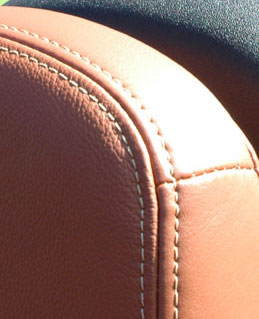 The
leather seating is very rich with contrasting stitching. Door panels are similarly
trimmed. If you're a fan of leather (I am), you'll be pleased with the MX-5.
The instrumentation is also done well. An intuitive layout, with attractive
aluminum trim, the gauges are easy to read under all conditions. There's even
a real oil pressure gauge! But then things take a slight downturn.
The
leather seating is very rich with contrasting stitching. Door panels are similarly
trimmed. If you're a fan of leather (I am), you'll be pleased with the MX-5.
The instrumentation is also done well. An intuitive layout, with attractive
aluminum trim, the gauges are easy to read under all conditions. There's even
a real oil pressure gauge! But then things take a slight downturn.
The plastic console looks like, well, plastic. Its too flat despite the ribbing that runs front to back. Some spots have a cheap appearance. Overall, a better job could have been done with the plastic. The black interior plastic trim isn't quite as bad. Still, the shiny black plastic trim across the dash is going to be a fingerprint magnet. Lets hope the aftermarket comes up with some interesting kits.
Another battle that was clearly a victory for the accountants over the designers was the one waged over the brake and shift boots. They're a cheap, pebbled, black vinyl that detracts from the richness of the leather. It goes from bad in the black interior, to worse with the tan leather interior. The tan version screams for matching tan leather brake and shift boots with contrasting stitching. Accessory makers - are you listening?
Music to the ears
So there I was, cruising down Kamehameha Highway, having a nice chat about the qualities of this great car, when suddenly it dawned on me: we're talking in a normal tone of voice! The high rear console of the cockpit, coupled with the small flip-up wind deflector between the seats, has a dramatic effect on the wind buffeting and overall noise level in the car. In addition to far less wind noise, the intake noise has been reduced by having moved the intake snorkel much further forward in the engine compartment. The result is that the sporty, exhaust note clearly emanates from the back of the car, and at a lower decibel level, instead of coming from "everywhere". Fans of a loud, throaty exhaust my even be a bit disappointed in the reduced volume. But for an audiophile, the exorcism of wind noise is an added bonus that further improves the sound system.
The boys at BOSE got it right. They've atoned for the sins inflicted on the second generation MX-5 with its lame factory BOSE audio system. The new BOSE sound system is, in a word, astonishing. The 7-speaker system is designed with separate equalization settings for top up vs. top down. Triggered by a switch when raising the top. This setting effectively raises the sound stage when the top is down to compensate for the entirely different acoustic properties of top up vs. top down driving. Once again, this is a driver's car, and the sound system follows the same path. After just a few seconds of listening, its clear that the sound stage is tuned for the driver's position. Vocals seem to emanate from directly in front of the driver instead of coming from the center of the dash. One fairly big omission, however: there is no auxiliary input to accommodate an iPOD, MP3 player, or other type of external audio source. Although sources at Mazda have indicated that the next generation of the audio system will have the additional input(s).
Topless maneuvers
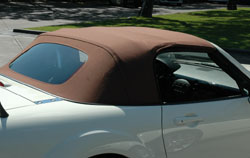 It
ain't a roadster without a retractable top. It needs to look good, be watertight,
be simple to operate, and provide good visibility through the rear. The new
MX-5 succeeds on all points.
It
ain't a roadster without a retractable top. It needs to look good, be watertight,
be simple to operate, and provide good visibility through the rear. The new
MX-5 succeeds on all points.
One of the problems of the early Miatas was the zip-down rear window. This added complexity, and was a weak spot in the original first generation design. Although the glass rear window supplied with the second generation Miata increased weight slightly, the added visibility makes it a worthwhile tradeoff. Still, the top required two latches, and needed to be covered with a boot to minimize wear and fading of the vinyl top material.
Enter the new third generation MX-5 soft top design. The single center latch makes it a snap to lower the top with one hand. A manual top is used to avoid the huge weight penalty of an automated, motorized top. The folding mechanism neatly self-forms into a flat boot without the need to snap on any added bits. The stack is prevented from rattling with a nifty latch in the rear of the cockpit console that securely holds the top in the lowered position. To raise the top, simply reach back, unlatch it, and pull the mechanism forward toward the front. Once again, the single latch secures it neatly into place.
The soft top is not only simple and efficient to operate, its also great looking. Fabricated from a very rich, tightly woven cloth, the soft top is far superior in the looks department to the old pebbled vinyl of past generations. Although with its somewhat delicate, finely woven appearance, time will tell if it can stand up to the wear and tear of use.
Only one driver, but not in the trunk
One area where the new Miata has changed only slightly is storage. Always a bane of roadsters, the storage space in the second generation Miata had grown to the point where two sets of golf clubs would fit into the trunk - a reasonable 5 cubic feet. The new MX-5 Miata trunk measures 5.3 cubic feet, although the shape is different, presumably due to the changes to the folding top. Still, we're beginning to think that the rumors of a future folding, integrated hardtop may just be true. A single set of golf clubs will fit back there, but the driver will have to come out of the bag.
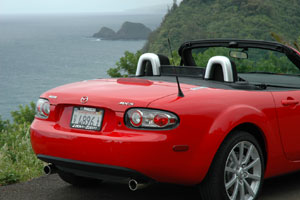 Making
things a bit tighter, there is really no option for utilizing the rear deck when
the top is raised, or for strapping down a soft "deck bag" to the
lowered soft top stack. Those few extra "unofficial" cubic feet of
storage were often a godsend with the first and second generation Miatas. Grand
Touring will be just a bit less grand with the new '5.
Making
things a bit tighter, there is really no option for utilizing the rear deck when
the top is raised, or for strapping down a soft "deck bag" to the
lowered soft top stack. Those few extra "unofficial" cubic feet of
storage were often a godsend with the first and second generation Miatas. Grand
Touring will be just a bit less grand with the new '5.
A few new storage spots have evolved from the cockpit design. In addition to the standard glove box, a new locking box has been integrated into the rear console. Big enough to hold a bunch of CDs along with some odds and ends, its certainly a necessity given the overall loss of storage. Two more spots are located behind the seats, and there is a small storage net alongside the passenger's side driveline tunnel - a good spot to keep a map or a notebook. The sun visors have a small plastic "ticket holder" built in, although personally, I prefer an elastic strap in the visor for more flexibility.
Regrettably, there is not a good spot for the iPOD or a cell phone. But there's always those cup holders.
Stylin'
There were three different design teams working on the new Miata styling - one each in the United States, Japan, and Germany. The concepts ranged from the more conservative, organic, retro styling coming out of Frankfurt, to the contemporary, youthfull, more RX-8 looking design from California. In the end, the Hiroshima design team ruled, but incorporated many concepts and features from the other two teams.
 The
result is an updated interpretation of a classic design. The contemporary fender
flares - more pronounced in photographs than they are in person - give a modern
appeal, while the overall body shape returns to the oval, convex contours that
marked the first generation Miata. Oval shapes tone down the contemporary clear
tail light lenses. The all-the-rage seat back hoops are more than just a cosmetic
nod to sportiness. They extend into the frame to contribute to structural integrity.
And while Mazda's legal department would claim the world is flat before allowing
the words "rollover protection" to be used in any corporate written
material, its clear from the cutaway model
that the occupants will benefit from the design.
The
result is an updated interpretation of a classic design. The contemporary fender
flares - more pronounced in photographs than they are in person - give a modern
appeal, while the overall body shape returns to the oval, convex contours that
marked the first generation Miata. Oval shapes tone down the contemporary clear
tail light lenses. The all-the-rage seat back hoops are more than just a cosmetic
nod to sportiness. They extend into the frame to contribute to structural integrity.
And while Mazda's legal department would claim the world is flat before allowing
the words "rollover protection" to be used in any corporate written
material, its clear from the cutaway model
that the occupants will benefit from the design.
Other updated styling features include the center brake light, moved from the integrated trunk lid design to a pod mounted on the deck. Door handles that were recessed in the past, now protrude. The "mouth" now has an integrated grill that gives a somewhat odd, flat appearance to the nose of the car. I would have preferred to see a recessed grill, giving the mouth a similar "scooped" look that characterized the early Miatas. Projector lamps and driving lights round out the body, while the stock 17 inch wheels (16 on the base packages) give the car an aggressive look, filling out the fenders nicely. An 18 inch dealer accessory wheel is available, but it looks too big and heavy for the car. Still, some will want to move in that direction, and those folks can be accommodated.
A rose by any other name...
Its no secret that Mazda has decided to allow the "Miata" moniker to quietly fade away. Miata badging has been included on all North American MX-5 cars since 1990, with one exception - the Mazdaspeed version. No one really even noticed the dropped Miata badge on the Mazdaspeed, however the lack of one on the third generation car has set off a small uproar. On one hand, its a bit surprising that Mazda has chosen to move away from such a well known, powerful brand name that has defined the car that brought back the roadster. On the other hand, the "chick car" image doesn't help sales, and the less fluffy MX-5 name may help in that department.
The car was always an MX-5. In Japan, it was badged "Roadster". In the rest of the world, it was just an MX-5. Still, those of us in the Miata community - at least in the North American Miata community - will always know it as a Miata.
A successful interpretation of a philosophy
Along with the critical goals of higher performance, lower weight, stiffer chassis, etc., was the important - no, essential - need to deliver the final product at the right price. With a base starting price of $20,435 (US$), Mazda has nailed it with room to spare. The 1990 Miata was introduced in 1989 with a base starting price of $13,800. Corrected for inflation, the cost of the '90 was actually $21,625 in 2005 dollars. The new 2006 car is coming in at a lower base price, yet includes many more features and much higher performance!
So what about Jinba Ittai?
I spent about half an hour chatting with one of the younger gentlemen from the Mazda team in Hiroshima. I asked him about Jinba Ittai, my primary interest being from a company cultural perspective. I was expecting a bit of marketing hype, mixed in with a description of the literal translation - "horse and rider as one." What I received was quite different. The gentleman became very serious, lowering his head slightly, as he explained that the Jinba Ittai philosophy was essential to the MX-5 program. Every employee was given training to ingrain Jinba Ittai and Kansei. The goal was to incorporate the philosophy into all aspects of the vehicle design. This overall theme was evident from the weight saving "gram strategy", where the smallest details such as reduction of excess fastener lengths were considered, to the tactile human factors testing, where a driver was wired with 42 sensors to monitor human response to various stimuli. I got the distinct impression that Jinba Ittai was taken very seriously by the design team.
Perhaps we as westerners will never be able to fully appreciate how eastern philosophy can translate beyond marketing hype into a product design. But clearly, the end result speaks volumes. The latest incarnation of what has been arguably the best affordable roadster in the world takes that concept to the next level.
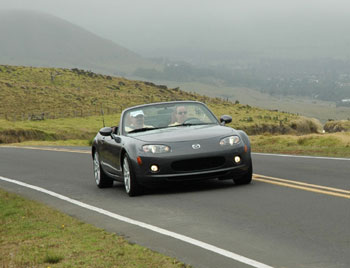
| [Home] - [FAQ] - [Search] - [Sponsors] - [Forums] |
| [Garage] - [Clubs] - [Contact Us] - [Disclosures] - [More...] |
Copyright
©1994-2024, Eunos Communications LLC
|